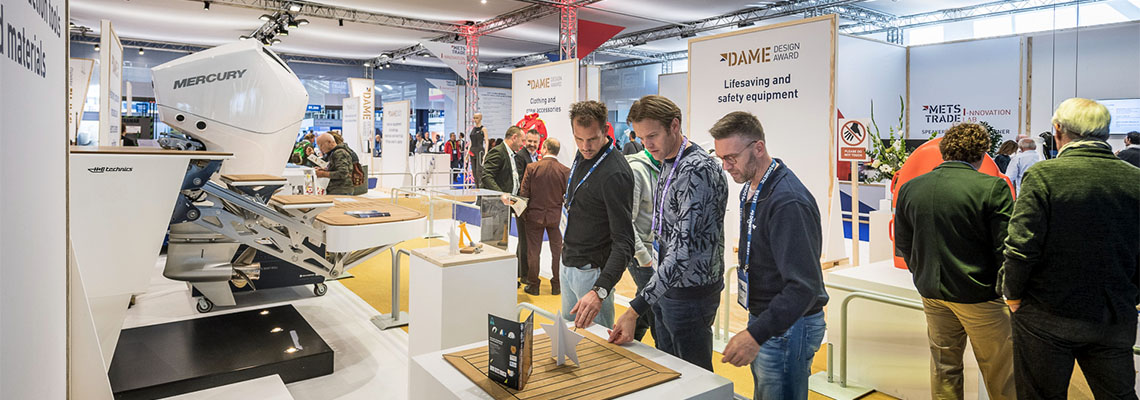ICOMIA Technical Consultant and DAME Award Jury member, Patrick Hemp, speaks to Kim Hollamby about the rapidly increasing number of marine equipment design priorities that are best addressed by bold approaches.
 ICOMIA (the International Council of Marine Industry Associations) brings together the interests of 37 national marine associations across the world, through a very active programme of international consultation, representation and research. Its uniquely global perspective is invaluable at many levels, including within the DAME Jury where ICOMIA’s Technical Consultant, Patrick Hemp, is a long-standing member. We caught up with him recently on a virtual call to his home in South Africa, to ask just how smart and brave the designers of marine equipment must be to meet the challenges that face us all in coming years.
ICOMIA (the International Council of Marine Industry Associations) brings together the interests of 37 national marine associations across the world, through a very active programme of international consultation, representation and research. Its uniquely global perspective is invaluable at many levels, including within the DAME Jury where ICOMIA’s Technical Consultant, Patrick Hemp, is a long-standing member. We caught up with him recently on a virtual call to his home in South Africa, to ask just how smart and brave the designers of marine equipment must be to meet the challenges that face us all in coming years.
The push for sustainability
Despite the recent focus on the pandemic, the key underlying topic is the environment, with its triple impetus of legislative change, moral imperative and customer preference. Our conversation starts there: “I think it's a difficult time because we are all talking about sustainability, but there are no clear pathways to achieve that."
Taking propulsion as just one obvious area, our IMEC Marine Engine Committee is very focused on drive train trends and the push for zero emissions. However there aren't a lot of simple options available that deliver a viable solution, so designers have to start looking at other industries.
It's time now that people start jumping in to try out some of a hundred different ways of producing alternative power that are emerging across all sectors. We know that electrification is not the only pathway to zero emissions and it also raises questions about whether we understand the full viability of an all-electric package, or hydrogen and other options, in terms of lifecycle assessment.
Lifecycle management
The need to assess lifecycle of course applies to any product, to understand its full impact on the environment. It's one of the biggest things that ICOMIA is encouraging. We have looked at several LCA (Life Cycle Assessment) tools and MarineShift360, with 11th Hour Racing as its founding sponsor, is a good example that we have worked with quite closely.
It’s a simple tool to use and allows for side-by-side comparisons of product creation choices, so that designers can see the full impacts from making changes to materials, sourcing and other factors. You can estimate manufacturing energy and water consumption as well as emissions for components, then test alternate ideas prior to committing to the final design. This kind of approach helps to answer the incredibly difficult question of what comprises a ‘sustainable’ piece of equipment or boat.
This raises another significant pressure regarding recycling and what to do with abandoned derelict vessels and the equipment they are fitted with. There’s no clear pathway here either, but we are learning and gaining knowledge from other sectors such as the wind generation industry. Ironically, some of the earliest boats were built very well and have relatively accessible hulls that are easier to refit with modern systems and breathe new life into – one person's throw away can be another person's amazing product.
“The underlying aim in the future though must be to design better products that can either be repaired to lengthen service life, or that are easily taken apart for very high percentage re-use."
Tough choices about materials
It’s clear that designers are having to make increasingly tough choices about materials, to minimise their impact on the environment, to maximise the chances of recycling and also to ensure they don’t harm the health of people working with them. Plus of course there’s the cost of the materials and of their use in production. If you want to launch a product globally, you need to look carefully at the legislation governing materials used. A boat cushion might seem simple, but the choice of an anti-biocidal material may not comply with the EU’s Biocidal Products Regulation.
If you couple those challenges with supply chain shortfalls, the added pressures of just-in-time manufacturing, the rising cost of raw materials, the pandemic-prompted boom in boating and the industry’s need to make getting afloat more accessible through simplicity of operation, then it’s clear that designers are facing a perfect storm. The industry also needs to ensure that it continues the progress on sustainability that was achieved before COVID-19 impacted everyone.
A licence to innovate
The positive part is that there is an increasingly wide range of choices that companies are able to make, including use of increasing ranges of recycled materials and adopting common parts across several models. Consumers will need to be educated in the benefits of unfamiliar materials and propulsion systems, but with an influx of new people into boating the market is most likely more open to change now than ever before.
“I am sure we’re also going to see new ideas crossover into the marine sector, from other industries and industrial designers. Those influences will help us all to rethink a lot of our traditional norms, which is what great design is all about."
“Our DAME 2020 R&D Excellence in Adversity Award winner last year was a brilliant example of a disruptive product. The Temo electric outboard ticks multiple boxes – most obviously, as a zero emissions propulsion system but particularly in the admirable simplicity of its form and function.
Reinventing marine equipment
We're going to see a lot more products of this kind come through. Whether they all survive or not is difficult to tell, but the future suggests that designers in the (leisure) marine industry will be less constrained by set pathways and in a stronger position to reinvent marine equipment that delivers on future demands.






